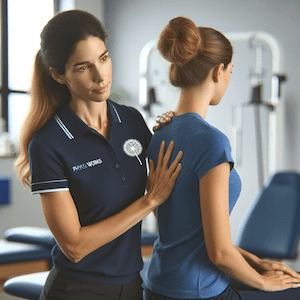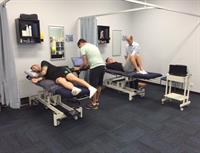Side Strain (Abdominal)
Article by John Miller

What is an Abdominal Side Strain?
Cricket fast bowlers and javelin throwers often experience abdominal side strain, which tears the internal oblique muscle from the undersurface of one of the lower four ribs or costal cartilages, causing pain and discomfort. MRI scans can diagnose the site and severity of muscle tear, and bony stress lesions may also occur but are less common.
The injury strongly correlates with bowling or throwing speed, putting the fastest bowlers or longest throwers at higher risk. The mechanism of injury involves sudden eccentric contracture with rupture of muscle fibres, which occurs during the lengthening of the muscle and superimposed eccentric contraction.
To prevent injury, warm-up and stretching before spells of bowling or throwing are essential. Additionally, keeping the torso warm and performing trunk rotation and side flexion exercises can help. Treatment for a side strain involves ceasing bowling or throwing immediately, applying ice to the painful area, and seeking professional treatment. Recovery time typically takes four to six weeks before a return to sport. Consulting a physiotherapist with a special interest in cricket or throwing for specific advice is beneficial.
What Causes Side Strain?
Researchers propose that side strain injury results from sudden eccentric contracture causing the internal oblique muscle fibers to rupture. This is due to the muscle’s lengthening during movements such as bowling and throwing, which can then lead to superimposed eccentric contraction and overstrain.
Studies focusing on fast bowlers have shown that the muscle tear usually occurs on the non-bowling arm side. For instance, in a right-handed bowler, the left arm is extended high above the body before being forcefully pulled through to allow the right arm to follow through and release the ball. At the fully extended position, the internal oblique muscle on the left side is at maximum tension or eccentric contraction. The internal oblique muscle is likely to rupture due to the sudden, vigorous motion from this eccentric contraction or pull-through that enables the dominant shoulder to flex and release the ball. Other throwing sports have a similar mechanism.
How is Side Strain Diagnosed?
MRI is sensitive for side strain injury evaluation, showing abnormalities in all patients with suspected muscular tear. Muscular avulsion from bony or cartilaginous origin may cause periosteum stripping, leading to excessive bleeding despite low-grade muscle tear.
How to Prevent Side Strain
Warming up and stretching the injury before the spells of bowling is very important. Keeping the torso warm and performing a series of trunk rotation and side flexion exercises are recommended.
Side Strain Treatment
It is crucial to cease bowling and to throw immediately after injury and ice the painful area. For best results and reduced recovery time, seek professional treatment for a side strain. Most side strain injuries require 4 to 6 weeks of rehabilitation before a return to sport.
Please consult your trusted cricket physiotherapist for specific advice.
Rochedale - Call 38410277
Book Online: RochedaleSalisbury - Call 32751044
Book Online: SalisburySandgate - Call 32691122
Book Online: SandgateCommon Cricket Injuries
Back Pain
- Back Muscle Pain
- Back Stress Fracture (Fast Bowlers)
- Facet Joint Pain
- Side Strain (Abdominal)
- Spondylolisthesis
Shoulder Pain
- Shoulder Impingement
- Rotator Cuff Syndrome
- Rotator Cuff Tear
- Bursitis Shoulder
- AC Joint Injury
- Dislocated Shoulder
Thigh & Hamstring Pain
Knee Pain
Shin & Calf Pain
Ankle Injuries
Neck Pain
Rochedale - Call 38410277
Book Online: RochedaleSalisbury - Call 32751044
Book Online: SalisburySandgate - Call 32691122
Book Online: SandgateEffective Management of Upper Back Pain and Injury
Physiotherapy Insights
Introduction
Upper back pain and injury, predominantly affecting the thoracic spine, are prevalent issues causing significant discomfort and impacting daily activities. This article, infused with physiotherapy insights, aims to enlighten the general public about the causes, symptoms, and treatment options for upper back pain.


Managing Upper Back Pain
Upper back pain stems from various sources, including thoracic spine conditions, joint injuries, muscle strains, nerve irritations, and systemic diseases. Recognising these causes is vital for appropriate treatment.
Common Causes of Upper Back Pain
- Joint Injuries: Facet joint pain is a frequent issue.
- Muscle-Related Injuries: This includes back muscle pain, side strains, whiplash, muscle cramps, and DOMS (Delayed Onset Muscle Soreness).
- Bone-Related Injuries: Conditions like Scheuermann's Disease, Scoliosis, and others.
- Disc-Related Injuries: Including bulging, slipped, or herniated discs.
- Nerve-Related Pain: Such as thoracic outlet syndrome and pinched nerves.
- Systemic Diseases: These include Ankylosing Spondylitis, Fibromyalgia, and arthritis types.
Posture and Upper Back Pain
Poor posture is a significant contributor to upper back pain. Understanding and correcting sitting, standing, and sleeping postures can prevent and alleviate pain.
Physiotherapy Perspective
A physiotherapist's approach to treating upper back pain involves assessing the individual's condition and tailoring a treatment plan. This may include exercises, manual therapy, and advice on posture correction.
Latest Research and Techniques
Recent advancements in physiotherapy have introduced innovative methods for treating upper back pain. These include targeted exercises, advanced manual techniques, and utilisation of posture-improving products.
What to Do?
If you experience upper back pain, it's crucial to consult a physiotherapist for a professional assessment and personalised treatment plan.
Conclusion
Upper back pain, though common, can be effectively managed with the right approach. Understanding its causes and seeking professional physiotherapy advice are key steps towards recovery.
For more information, explore articles at PhysioWorks.
Related Articles
Joint Injuries
Muscle-Related Injuries
Bone-Related Injuries
Disc-Related Injuries
Nerve-Related / Referred Pain
Systemic Diseases
Posture Information
- Posture Syndromes
- Posture Improvement: A Guide to Improve Your Posture
- Improving Your Posture: A Guide for Better Health
- How to Achieve Perfect Posture




